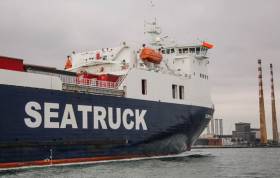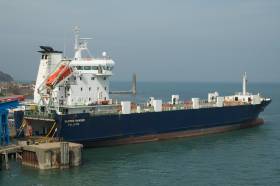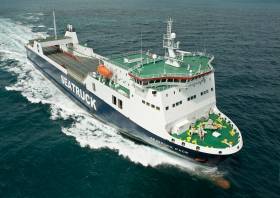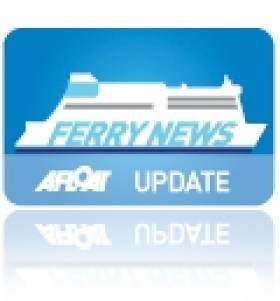Displaying items by tag: Seatruck Ferries
#FerryNews- Heysham Port on the Irish Sea, is where a new link-span bridge was officially unveiled, as part of £10m investment by the port owner-operator Peel Ports to increase throughput at the Lancashire port in north-west England.
The investment according to Peel Ports is a direct response to the economic potential facilitated by the Bay Gateway link road that connects Heysham directly with the M6.
The port is already a key gateway for Irish Sea trade with numerous daily sailings operated by Seatruck, Stena Line and the Isle of Man Steam Packet Company.
As well as the new link-span, which provides a third berth for freight and passenger traffic, the investment also includes a new port entrance and a pontoon for offshore crew transfer vessels, which is currently under construction and is set to open later this year.
A new terminal operating system supplied by Hogia has also been introduced to digitise the management of freight transport through the terminal, helping to improve operational efficiency.
The investments by Peel Ports have been made within 18 months of the opening of the new £140m link road which bypasses congestion in Lancaster. The 4.8km route cuts the journey time for goods traded between the UK and Ireland by 30 minutes, offering a significant cost saving to cargo owners and hauliers.
According to some studies before the road opened, the economic growth forecast could potentially support 250 new jobs in port-related activity and hundreds more in haulage, logistics and distribution. It is estimated that for £1 invested, the link road will earn £4.40 for the local economy.
Irish Sea Freighter Seatruck Ferries Surge Continues
Irish Sea freight specialist Seatruck Ferries had another strong year of growth in 2017. Volume across the three routes increased at just over 10% compared with an overall market growth of *3.9%. (* source IRN Freightstat)
Since 2015 Seatruck volumes have risen over 30% as their long sea unaccompanied service has significantly grown in popularity.
Over this period Seatruck has committed additional tonnage and increased sailing frequency in line with customer demand. Seatruck now operates 76 departures per week on their 3 routes which operate between Heysham - Warrenpoint, Heysham - Dublin and Liverpool - Dublin.
Strongest growth has been into Dublin where Seatruck now operate 5 departures per day in the busy midweek period.
Seatruck believe that the continued and worsening HGV driver shortage in Ireland and the UK is leading to a growth in unaccompanied trailer shipments as operates seek to use this vital resource more efficiently. By shipping trailer only, from ports which reduce road mileage compared with the traditional transit through Wales or Scotland, operators can make significant door to door savings in what is an increasingly competitive logistics landscape.
In the coming weeks a new £7m loading ramp will be installed at Heysham Port which will provide Seatruck with an enhanced service in the Port from the new dedicated facility
Supramax Bulker Joins Danish Group’s Ferry Subsidiary Seatruck Ships in Dublin Port
#Clipper/Seatruck - A trio of ships from the Clipper Group have used Dublin Port this afternoon, however one of them is not a port regular given the vessel is a bulker and not a routine ro-ro freight ferry trading under subsidiary, Seatruck, writes Jehan Ashmore.
The ‘Supramax’ bulker, Clipper Triton of 61,448dwt had previously called to Cork Harbour at Ringaskiddy’s (DWB) deepwater berth. This procedure of calling first to discharge in Cork followed by Dublin echoes the call of Arklow Shipping’s bulk-carrier, Arklow Spirit.
Likewise of the Irish flagged ship, Clipper Triton is alongside Alexandra Quay West where the dry-bulk facility is located. Also similar to the ASL bulker, is that the Clipper Triton has five cargo holds and that are serviced by four 30.5 metric ton cranes equipped with grabs.
Clipper Group with its headquarters in Denmark, was established in 1972 and has expanded into operating a large mixed fleet comprising of five vessel type categories. More than 200 people work in the Group's offices throughout nine countries around the world. The Group is engaged in chartering and operations departments, fleet and technical management along with shipping services and in corporate functions.
In the bulk-carrier fleet alone, 150 such ships are operated. They range primarily from 28-38,000dwt handysize vessels of to 55-66,000dwt Supramax (incl. Clipper Triton) and Ultramax vessels.
The rest of the mixed fleet are ro-ro freight ferries, car-passenger ferries and a pair of cruiseships. One of them, Silver Discoverer in a previous guise as Clipper Oydessy had visited London/Derry’s city quays, though the vessel's name change occurred in 2013.
The primary activities of the Group’s ro-ro services on Irish Sea are those operated by Seatruck Ferries. Of their 10 strong fleet, four use the original freight-ferry naming theme prefix ‘Clipper’. The balance of the more modern fleet have ‘Seatruck’ to reflect the trading name of the operator’s Irish Sea route network.
An example of this freight-ferry fleet is Clipper Point (5,100dwt), which is berthed at Terminal 5 and where the vessel is to depart this afternoon to Heysham. Also to berth at the terminal’s same linkspan is Clipper Ranger (5,800dwt) having sailed from Liverpool.
Capacity on the Central Corridor route was last month increased to 40 departures weekly. Employed on the service are the aforementioned Clipper Ranger which joined Seatruck Pace along with the larger pairing of sisters, Seatruck Power and Progress.
As Afloat reported this day last week, Seatruck marked a decade of operations in Dublin Port, where on their service to Liverpool was originaly served by single-ship Celtic Star. This chartered ro-ro had used Terminal 3 located also in Alexandra Basin where Clipper Triton will remain until departuring tonight.
In addition to Seatruck, the Group also have passenger ferry services that are co-owned through Clipper Group A/S. They operate an extensive ferry network in Denmark that trade as Danske Færger (Danish Ferries).
Seatruck Ferries Celebrate 10 Years of Operation in Dublin Port
#ferrynews - Freight ferry operator on the Irish Sea, Seatruck Ferries celebrate 10 years of service using Dublin Port from where the shipping company's traffic volumes have grown exponentially.
From small beginnings in October 2007, Seatruck had a single ship service using freight ferry ‘Celtic Star’. The ro-ro ship had previously ran for another operator Celtic Link Ferries on the Irish Sea. This operator no longer remains in business.
In that first year, Seatruck transported just over 3,000 units of freight from Dublin. Roll on a decade later and compare that figure to just under 21,000 units in October 2017, representing growth of well over 500%. According to IRN Freightstat, the operator are now one of the largest freight movers in the capital port.
In the busy midweek period Seatruck operate 4 daily services to Liverpool and a daily service to Heysham. Seatruck also operate on the Warrenpoint - Heysham route which commenced in 1996.
With driver shortages continuing Seatruck are expecting an ongoing switch to unaccompanied trailer movements which they specialise in with their purpose built freight only ferries.
CEO of Seatruck Alistair Eagles comments; “10 years on from the commencement of our services into Dublin port we are very much focusing on the next steps to ensure that we can continue to help our customers save money and use their equipment and drivers more efficiently. Seatruck is fully committed to our freight only model and we are planning for a continued industry switch away from the driver accompanied, short sea mode.
Our Dublin services are an extremely important part of our route network and I on behalf of everyone at Seatruck would like to personally thank all of our customers for their support”
In December, a new loading ramp will be installed in the Port of Heysham which will further enhance the operator's Irish Sea services from the UK Port, which is now directly linked to the motorway network via the new £130m M6 Link.
Seatruck are working closely with the relevant authorities in Northern Ireland on the Newry Southern Relief Road. The project will link Warrenpoint Harbour directly to the Belfast - Dublin motorway.
Freight Levels Rise As Seatruck Benefit from Heysham Port Relief Road
#FreightRise - Freight levels at Seatruck have grown by a third with further gains expected in the coming months as the Port of Heysham now has a new £125m Bay Gateway relief road.
The operator headquartered at the port according to Insider Media has revealed that freight levels so far in November 2016 have been 30% up on November 2015.
Chief executive Alistair Eagles also forecasted that Seatruck will win even more business from hauliers switching ferry operators as a result of the opening of the relief road on 31 October 2016. The route bypasses the previous bottleneck of Lancaster, slashing journey times between the M6 and the port.
He said: "The new Bay Gateway relief road is a game changer. It sends a massive message to the transport industry that the Port of Heysham is now a hugely more competitive alternative to more remote ports like Holyhead and Cairnryan.
"Hauliers no longer have to wrestle with congestion around Lancaster and the Heysham peninsula."
In October, Seatruck added a larger vessel Clipper Point to its Heysham-Dublin route, almost doubling capacity. At the same time, the company added a fourth vessel, Clipper Ranger to its Liverpool-Dublin service.
Seatruck Launch New Dublin-Bristol Route
#NewRoute - Seatruck Ferries, the Irish Sea’s dedicated unaccompanied freight operator, has begun a weekend service connecting Dublin and Bristol.
The UK west coast port, Bristol is a major hub for car imports, and the connection allows car manufacturers to enter Ireland directly without the need for a UK trunk. The new service uses a Seatruck ro-ro vessel that would otherwise be idle at the weekend.
The operator which celebrates its 20th year has a network of three routes: Heysham – Warrenpoint (their first route) Dublin-Heysham and Dublin-Liverpool.
With the summer just gone, this is normally a quieter period, however, Seatruck Ferries have reported strong growth and new service offerings on its Irish Sea routes. During August alone, shipment of unaccompanied trailers was 24.9% increase compared with the previous year.
By operating to Heysham and Liverpool, this allows freight operators using unaccompanied trailer shipments to use their drivers and equipment more efficiently.
The English ports providing significant road mileage savings compared with the traditional transit by other operators through ports in Wales and Scotland.
#AwardFinalist - Seatruck Ferries, the Irish Sea's only operator dedicated to ro-ro freight, have been selected as a finalist for 'Company of the Year' at next month’s 2016 Lloyd's List Global Awards, writes Jehan Ashmore.
The freight company, part of the Danish owned Clipper Group, has a network of three routes: Dublin-Liverpool, Dublin-Heysham and Warrenpoint-Heysham. The last route linking Northern Ireland and England is where Seatruck began operations twenty years ago in 1996.
The Lloyd's List Global Awards, are widely regarded as the ‘Oscars’ of the worldwide shipping industry, which are to take place in London at the National Maritime Museum, Greenwich on the 28th September.
Also nominated for the Company of the Year award are CMA CGM, Hapag-Lloyd, Maersk Line, Pyxis Tankers and Waterfront Shipping Company.
In the first 6 months of 2016, Seatruck Ferries recorded Irish Sea freight growth of over just 18%, three times the market level of 5.8%. Strongest growth was achieved on the central corridor between Liverpool – Dublin, where in March was introduced a larger third ‘P’ Class freight vessel, Clipper Pace (1,850 lane metres).
#LargerVessel – A larger third Seatruck Ferries ro-ro vessel will be added to the Dublin-Liverpool route today.
The current vessel, Clipper Ranger will be replaced by the larger and faster P series vessel, Seatruck Pace which will almost double the freight capacity with space for 110 trailers per sailing.
As reported on Afloat, Clipper Ranger was only added in mid-November 2015 but has already attracted significant flows of new traffic since its introduction.
The deployment of Seatruck Pace, a proven P series vessel as the third vessel to run alongside a pair of larger FSG vessels will ensure Seatruck offer three sailings daily in each direction to cope with continued growth on the central Irish Sea route.
The vessel switch is in direct response to demand and feedback from Seatruck customers and this has led to that tailored sailings schedule to reflect changing needs of the Irish market. Crucially it will add further capacity during the busy midweek period.
The 1,830 lane metre capacity Seatruck Pace will bring speed, schedule reliability, free height and even faster turnaround times in port. Drivers will now have single berth en-suite cabins and comfortable lounge area. In addition the ship benefits from a ramp interface to the lower hold in place of a lift.
Driver shortages are causing operators to reassess their traditional accompanied method. Seatruck Ferries believes in a switch to greater volumes of unaccompanied movements from ports, which reduces road mileage compared with the transit through Wales or Scotland.
As economic conditions improve, this addition is the next stage in Seatruck Ferries’ strategic development plan and complements the operators existing Warrenpoint-Heysham and Dublin-Heysham services.
New Freight Leadership to Take Helm of Seatruck Ferries
#FreightLeadership – Irish Sea ro-ro freight-only operator, Seatruck Ferries have appointed Alistair Eagles as the company's new CEO with effect from 7 May this year.
Concurrent to this, Ole Frie will step down from his position as Chairman for Seatruck, and Kristian Morch will become the new Chairman of the Board.
Eagles was part of the original team that founded Seatruck in 1996. He has been Commercial Director and since 2009 Managing Director Irish Sea for Seatruck. The 44 year-old has a degree in Transport Management from Loughborough University.
Together Fre and Eagles have been instrumental in the turnaround of Seatruck. Since 2012, the company has seen a very positive development, initiated by strong volume growth on the Irish Sea and the successful employment of the other vessels in the external charter market.
Frie joined Seatruck in 2007 and has taken a very active role in the business since then. He brought with him decades of experience from DFDS, where he stepped down as CEO in 2006.
Seatruck Ferries Voted Irish Sea Shipping Line of 2014
#SeatruckAward- Seatruck Ferries was voted Irish Sea Shipping Line of 2014 at the annual Export & Freight Transport & Logistics Awards held in Belfast recently.
This was the second year in succession that the ro-ro freight company was presented with the much coveted award, sponsored by DSV.
A selected group of hauliers were asked to anonymously pick one service which offered the optimum level of service, quality, on-board facilities and choice of routes, registered their votes via a totally secure and carefully policed on-line 'one customer one vote' system.
Those attending the awards ceremony held in the Ramada Hotel heard that "Seatruck has truly stretched the boundaries of traditional shipping services. It remains the only Irish Sea operator solely focused on the transportation of unaccompanied freight."
Among the developments of the operator this year was the replacing in April of Arrow on the Dublin-Heysham route by the much larger "P" series vessel, Seatruck Pace which as previously reported, Afloat.ie interviewed one of her masters.
The vessel's introduction bringing speed, schedule reliability and additional capacity are factors in which the operator confirmed strategic importance to the route.
On the Dublin-Liverpool service, a refit to all freight passenger twin-berth cabins were carried out on the pair of FSG vessels Seatruck Power and Seatruck Progress.





































































